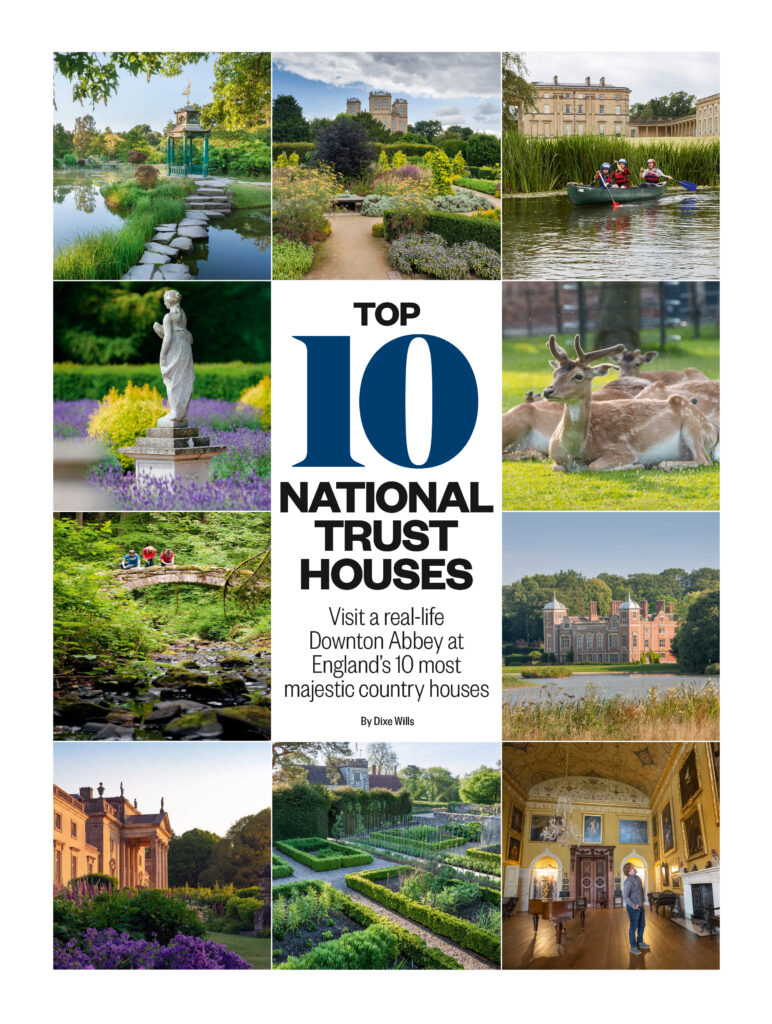
Opening times vary so check the NT website before leaving home. nationaltrust.org.uk
1 Cliveden, Buckinghamshire
Scandalously luxurious
Best for… BOATING

Built in 1666 by the 2nd Duke of Buckingham as a lavish gift for his mistress, Cliveden has famously passed through the hands of dukes, earls, viscounts and even a prince. However, the house is most associated with one family – the Astors. William Waldorf Astor was the richest man in America when he paid $1.2m for the house in 1893. He was made First Viscount Astor and his daughter-in-law, Nancy Astor, became the first woman in the UK to take a seat as an MP.
But the family never recovered from arguably the biggest scandal of the 1960s: the Profumo Affair. The married Secretary of State for War John Profumo met 19-year-old model Christine Keeler at Cliveden and they began a relationship. However, she was also seeing a Soviet naval attaché. This was an awkward state of affairs and Profumo was forced to resign. Today Cliveden – perched high above the Thames atop a chalk cliff – doubles as a luxury hotel, but you can still grab a guided tour that includes the family chapel. The grounds are open to the public and comprise 121 hectares of woodland and 32 hectares of formal gardens, including an oriental water garden and a maze. You can even hit the Cliveden Reach of the Thames on a mini cruise or by hiring one of Cliveden’s wide variety of boats (boatingatcliveden.co.uk).
Useful info
• Gardens opening hours: 9.30–5.30 (winter 9.30–4).
• Café; plant shop; second-hand bookshop; accessible toilets; wheelchair hire; dogs welcome.
Opening times vary so check the NT website before leaving home. nationaltrust.org.uk
2 Kingston Lacy, Dorset
Italianate splendour
Best for… VIEWING ART
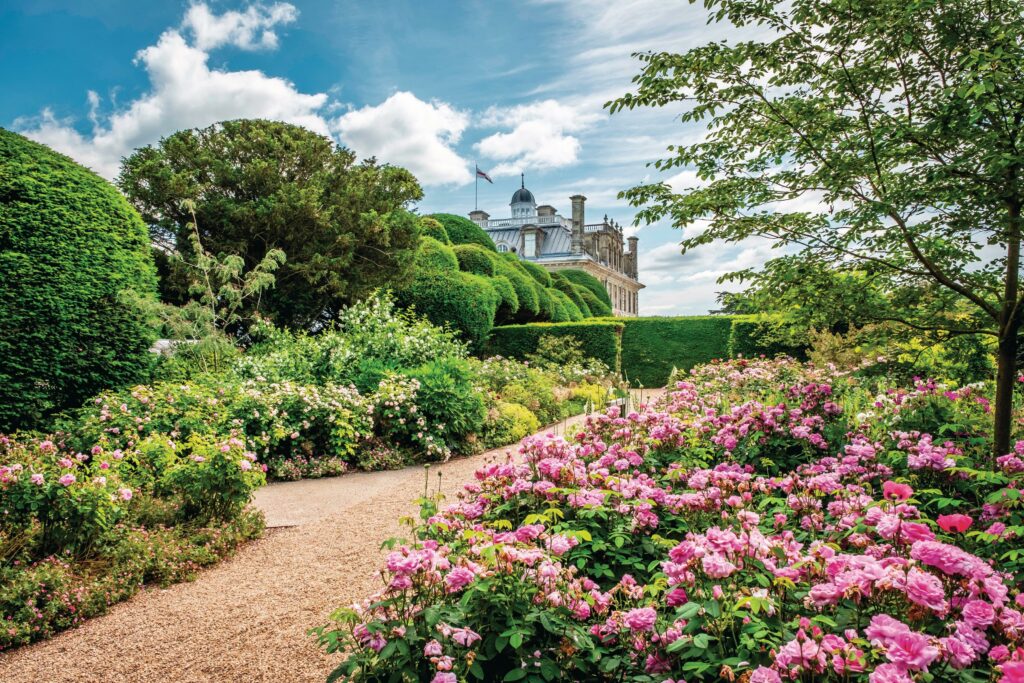
Fancy going to Venice without leaving Britain? Well, it’s perfectly possible. At least, that’s what the explorer William John Bankes would have had you believe. He took the house he inherited – built in the 1660s by his ancestor Ralph Bankes – and had it remodelled to resemble a Venetian palace.
The work was carried out in the 1830s by Sir Charles Barry, who also designed the Houses of Parliament. Bankes’ vision was to turn the house into a work of art, one that was filled with beautiful things in the style of the Venetian palazzi.
As an inveterate adventurer, Bankes had travelled through much of Europe and south along the Nile, deep into Egypt. He brought the treasures acquired during these expeditions to Kingston Lacey. His legacy is an art collection now considered to be the most impressive in the National Trust’s care and includes paintings by Rubens and Titian.
Useful info
• House opening hours: 10.30–3 (winter 10.30–2.30).
• Café; shop; accessible toilets; wheelchair hire; dogs welcome in the parkland.
3 Dunham Massey, Cheshire
Go ‘below stairs’
Best for… SERVANTS’ QUARTERS
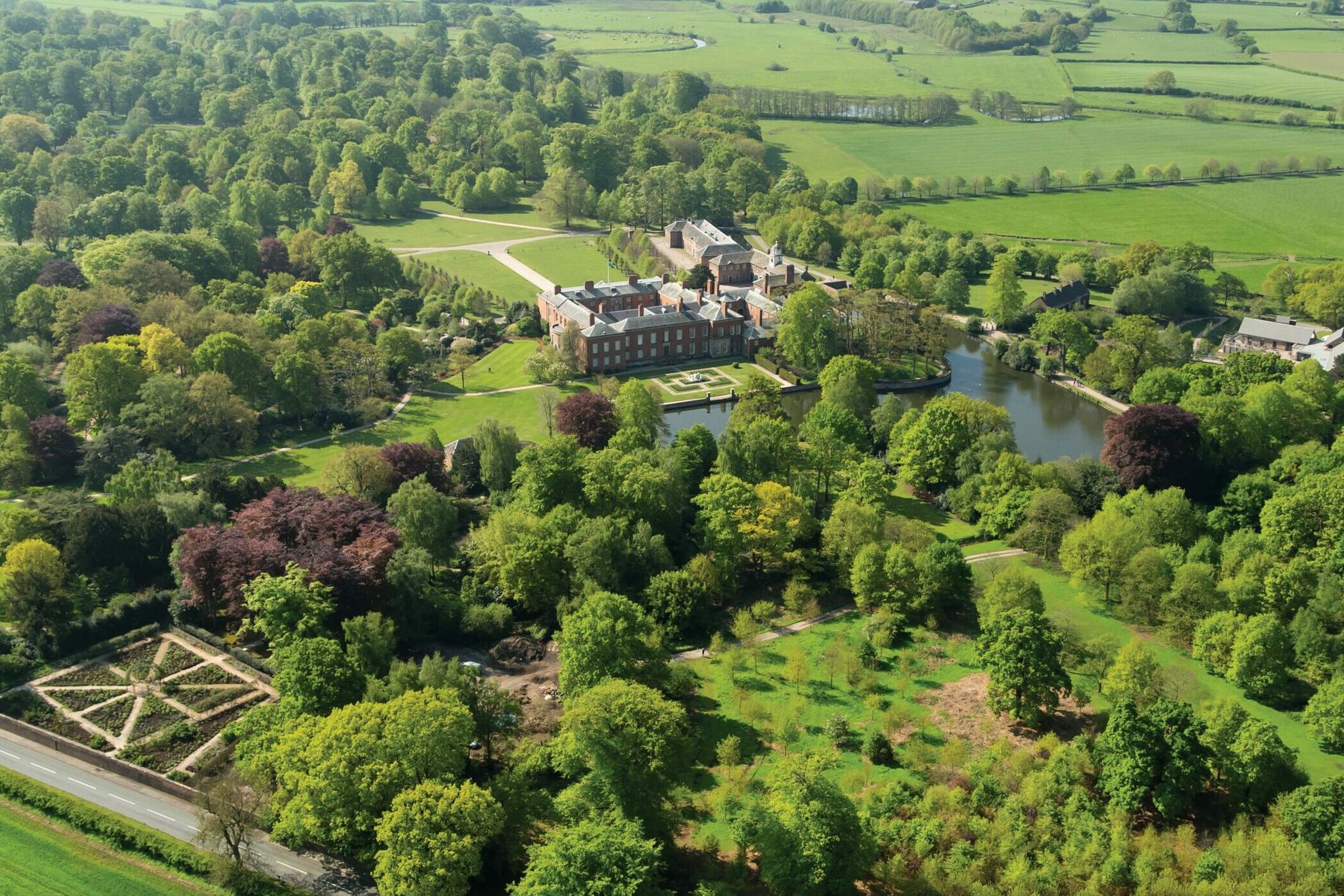
This moated Georgian house is the result of a substantial rebuild by the 2nd Earl of Warrington in the early 17th century. Its later history reveals the prejudices of Victorian England. The 7th Earl of Stamford, for example, was married twice – to a shoemaker’s daughter (who died) and a circus performer. This made him deeply unpopular with the snooty local gentry. He eventually moved out of Dunham Massey, never to return. The title and house passed to a distant cousin who was a farm labourer in South Africa married to the daughter of an emancipated slave. However, their eldest son, John, who was of mixed race, was barred from becoming the 9th Earl because he had been born before his parents married.
While most grand houses concentrate on life ‘above stairs’, a visit to Dunham Massey begins where many of the servants spent their days: in the kitchen, laundry and dairy. All three have been wonderfully restored to give a real sense of the hard work carried out by those of humbler birth.
Heading outside, fallow deer still roam a 121-hectare park that has existed since at least 1362. There’s all-yearround colour to be enjoyed in the grounds, which include one of Britain’s largest winter gardens. And visitors can also take a tour of the estate’s 400-year-old water mill.
Useful info
• Gardens opening hours: 10–5 (winter 10–4).
• Café; restaurant; book shop; shop; parkland; accessible toilets; wheelchair hire; dogs welcome. Also nearby: Rostherne Mere National Nature Reserve, with a lake full of birds. cawos.org
4 Ightham Mote, Kent
Medieval sumptuousness
Best for… A MAJESTIC MOAT

Built of Kentish ragstone and Wealden oak, with a stylish moat dug for protection – Ightham Mote was once the very height of decorous country living. A sort of 14th-century Downton Abbey, if you will. Ightham is not only one of England’s oldest surviving manor houses, it’s also one its most complete, having altered little over nearly 700 years.
Unusually, the identity of the individual who had the house built has been lost to posterity. All we know is that, within 20 years of its construction in the mid1300s, it came into the hands of Thomas Cawne, the son of a tailor and tenement landlord. Thomas was an army captain and, since this was at the time of the Hundred Years’ War (which went on for 116 years), he probably chose Ightham because its location allowed him easy access both to his friends in London, and – whenever he needed to do some soldiering – to France.
Subsequent owners include an aunt to an English queen, a ‘gentleman composer’, a Commisioner of Sewers, and Sir Thomas Colyer-Fergusson, who employed a dozen servants and eight gardeners and always ate off his finest porcelain.
Hidden away in a narrow valley, Ightham is blessed with 202 hectares of woodland, as well as gardens, lakes, pleasure grounds, an orchard and a play area.
Useful info
• House opening hours: 11–4.30 (winter 11–3).
• Café; book shop; shop; gardens and parkland; accessible toilets; wheelchair hire; dogs allowed in the gardens Nov–Feb. Also nearby: Knole House, one of England’s grandest stately homes.
5 Attingham Park, Shropshire
Style on a vast scale
Best for… FAMILY FUN

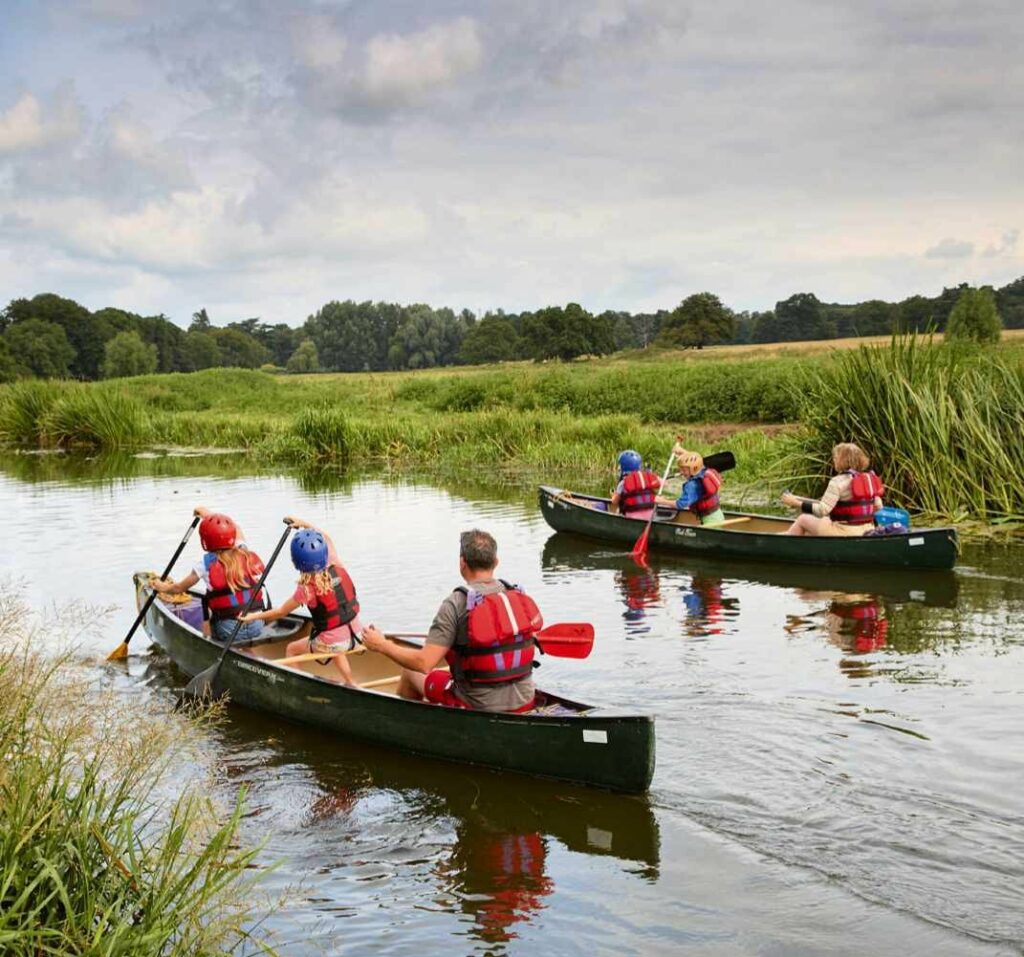
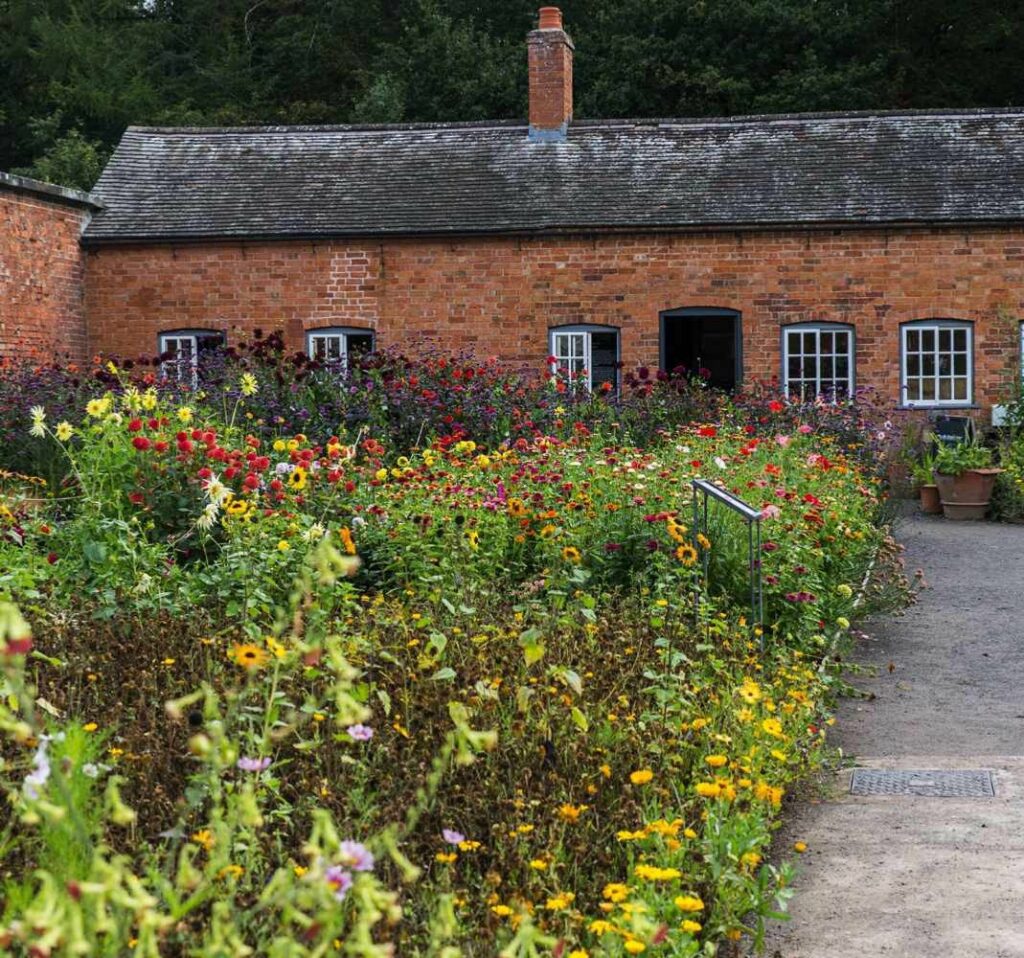

There’s wealthy and there’s wealthy. The motto of the Hill family – who became the Lords Berwick – was ‘Let wealth be his who knows its use’. So they commissioned a vast Georgian mansion in the Regency style, which was set in 81 hectares of parkland on a 3,237-hectare estate. They emptied and levelled a nearby village that was “in the way”. They diverted the route of the London to Holyhead trunk road away from their house. Oh, and they owned a working model of Mount Vesuvius. Which of us doesn’t? Today the estate runs to a paltry 1,618 hectares (that’s still over six square miles) with the Tern and Severn Rivers flowing across it and woodland to explore on specially designed walking routes.
Attingham is a particularly fun place to take children. This summer there’s a straw-bale fortress to have adventures in, a ‘Field of Play’, complete with apparatus, an amazing wheelchair-accessible tunnel, and sports equipment you can borrow (with a café and loos nearby). During the school holidays, the Summer of Play includes a calendar of events for the whole family. There are also natural play areas around the estate, too, where children can mess about in streams.
Just one word of warning: this is the National Trust’s most popular property, with more than half a million visitors a year, so try to go off-season to avoid the largest crowds.
Useful info
• House opening hours: 11–4 (winter 10–3.30).
• Café; shop; parkland; walled garden; playground; accessible toilets; wheelchair hire; dogs on leads welcome. Also nearby: Attingham Home Farm – a historic working farm.
Photos: National Trust Images/Rob Coleman, Arnhel de Serra, Matthew Antrobus, Annapurna Mellor, Chris Lacey, Andrew Butler
6 Cragside, Northumberland
A technical first
Best for… SCIENCE FANS
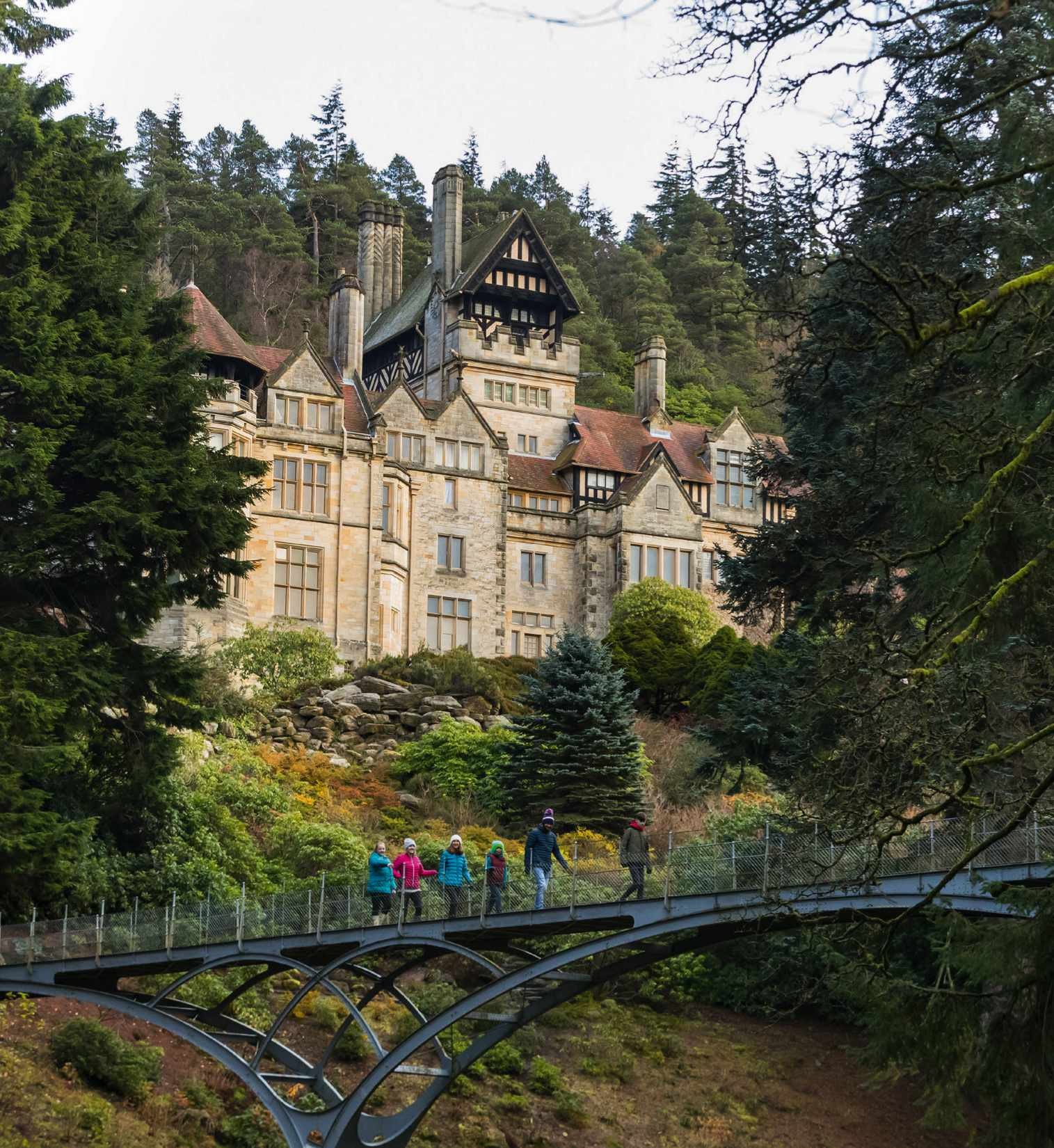
It’s fair to say that William Armstrong did not do things by halves. Born in Newcastle in 1810, he became an amateur scientist, inventing a hydraulic crane. Setting up a company to produce his creation was the first step on the road to becoming a major industrialist. He moved swiftly into weaponry and warships and it’s said that he almost single-handedly armed Japan in the Russo-Japanese War. He was knighted, then made 1st Baron Armstrong.
The enormous wealth that arms manufacturing brought gave Armstrong the chance to build the house of his dreams. The result was Cragside, an immense mock-Tudor pile on a hillside near Rothbury that architectural historian Nikolaus Pevsner was to call “the most dramatic Victorian mansion in the north of England”. And thanks to five carefully situated artificial lakes, he created the world’s first hydro-electricity scheme (and the world’s first house to be powered by one). With this plentiful power he was able to introduce brand new technology that made Cragside the most cuttingedge house on the planet. He installed electric lighting, a dishwasher, a washing machine, a vacuum cleaner, an automatic plant-watering device and a telephone system. He also built several follies and grottoes on his estate, and planted seven million trees and shrubs.
Saved for the nation in 1977, Cragside offers up a unique glimpse into the future, as seen by a Victorian.
Useful info
• House opening hours: 11–4 (closed from 6 Nov).
• Tea room; shop; garden; accessible toilets; wheelchair hire; dogs welcome outdoors.
7 Hardwick Hall, Derbyshire
A palace built for a countess
Best for… ELIZABETHAN SPLENDOUR

‘Bess of Hardwick’ is a cracking moniker and it belonged to a pretty impressive woman. Born around 1521, she was widowed four times. Her first husband was a boy of 13 who died after 18 months. With her second husband she had eight children in 10 years before inheriting a (well-earned) fortune. From her third she inherited another tidy sum. From her fourth she obtained a swanky title – Countess of Shrewsbury. A month after the death of this fourth husband, she began construction work on her new home: Hardwick Hall.
Built in the Italian Renaissance style with an English spin, Hardwick was, astonishingly, the first English house that was architectdesigned. Hardwick Hall remains little changed from its days of Elizabethan splendour. Inside, you’ll find an extremely fine assortment of 16th and 17th-century tapestries and furniture that helped make it one of the most lavish of its day.
Useful info
• House opening hours: 11–3.30 (winter 11–3).
• Restaurant; shop; accessible toilets; wheelchair hire.
8 Belton House, Lincolnshire
Lavish interiors
Best for… 20TH-CENTURY HISTORY
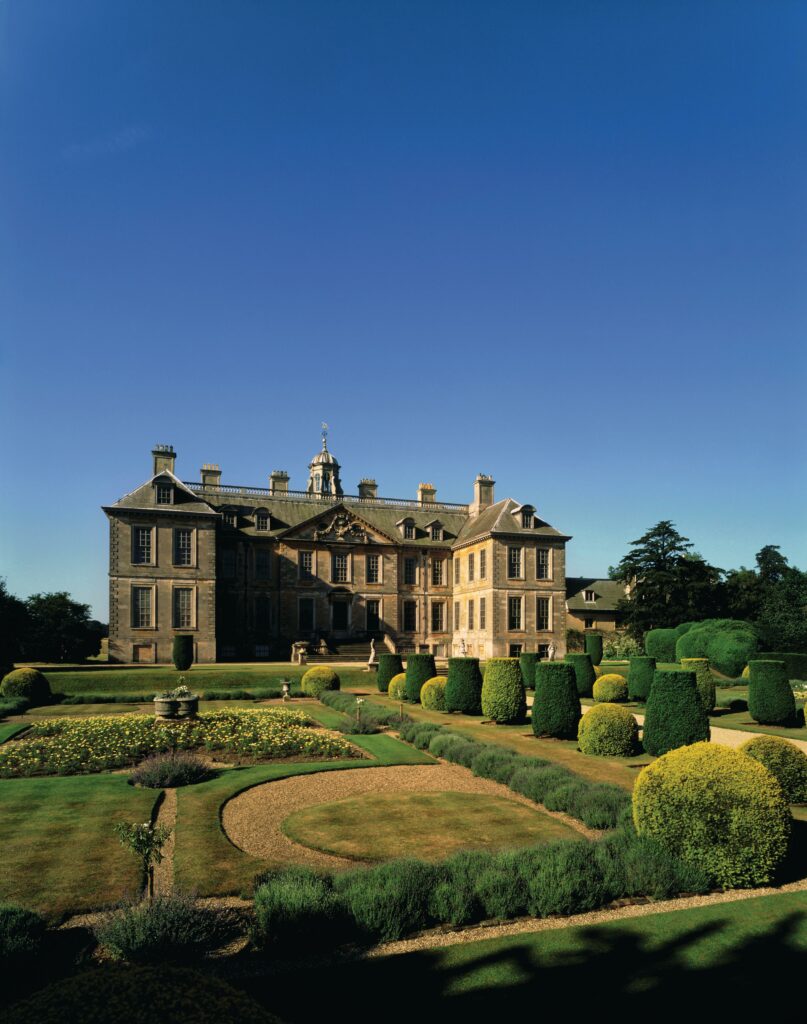
Ever since 1685, when work began on the Carolean-style mansion, money has been absolutely lavished on Belton House. Sir John Brownlow employed the very best designers and artisans in its creation. When the Industrial Revolution came along, an orangery was built with a cast-iron frame fresh from the furnace. The interior of the house was filled with the finest silver and porcelain and appointed with one of the country’s largest libraries.
But it hasn’t all been silver service and garden parties. In the First World War, Belton was transformed into a veritable town when a so-called Kitchener Camp was created in the grounds. Barracks housed 20,000 trainee troops and electricity, water and sewage services were laid on.
Now, there are Dutch and Italian-inspired gardens to enjoy and 526 hectares of parkland, plus a large outdoor adventure playground and miniature train.
Useful info
• House opening hours: 11–4 (winter 11–2.30).
• Café; shop; book shop; garden; park, indoor play; playground; accessible toilets; wheelchair hire; dogs on leads welcome.
9 Stourhead, Wiltshire
“A living work of art”
Best for… LANDSCAPED GARDENS
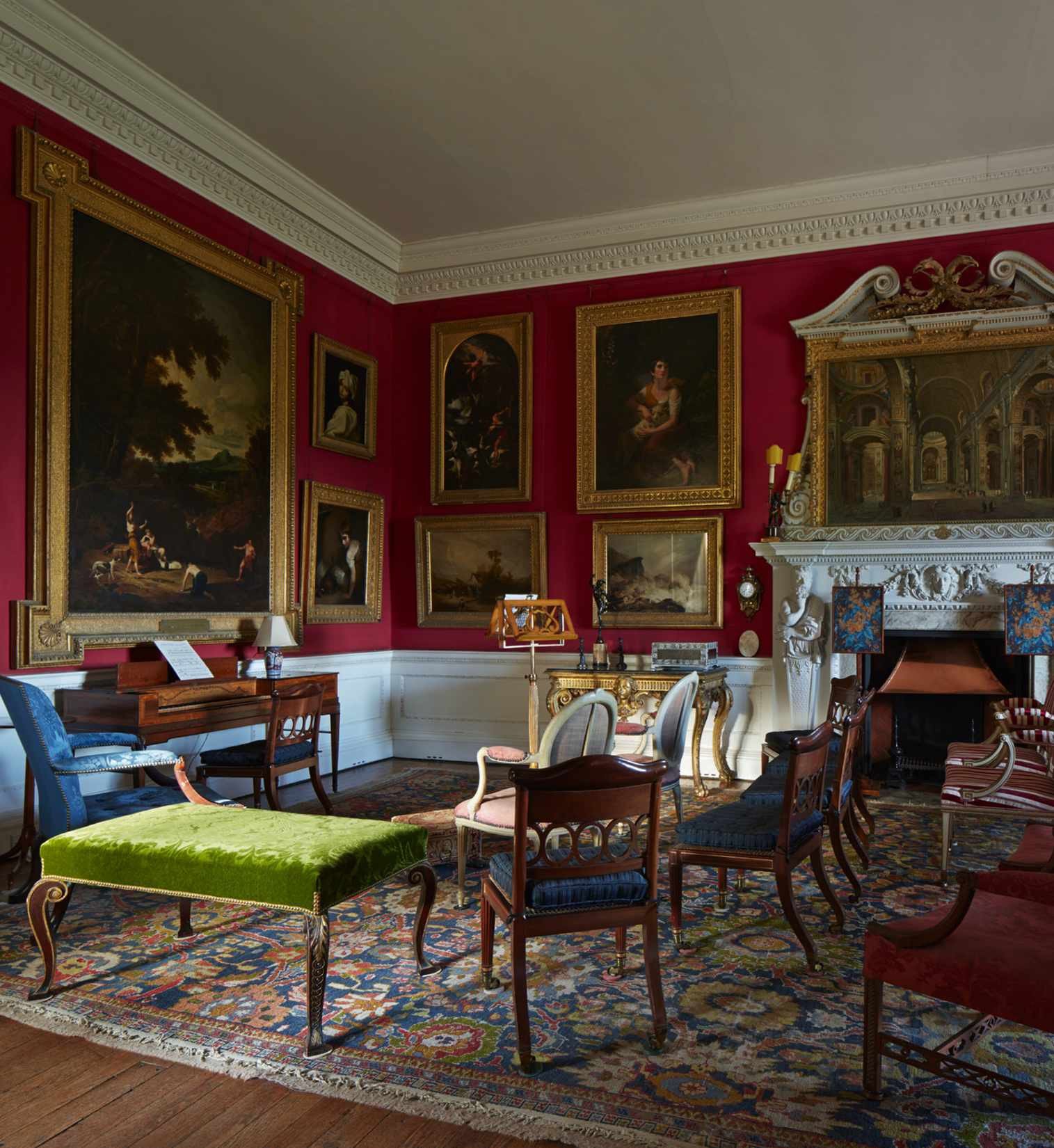
The parks of England’s stately homes are renowned for their beauty. Often landscaped in the 18th century by artists such as Lancelot ‘Capability’ Brown, they created little Elysian worlds for their wealthy owners, insulating them from the everyday struggles of lesser mortals. But then there is Stourhead, a park on a higher plain, that casts all others into the shade. While some grand estates have artificial lakes that improve the view, Stourhead’s lake tells an epic story: with its temples, grottoes and Palladian bridge, a walk around it is intended to conjure up a vision of Greek hero Aeneas’ journey down into the underworld.
The park was acquired in 1717 by Henry Hoare I, whose father Sir Richard founded Hoares bank, which is still run by the family today. Henry had one of the country’s first Palladian-style villas built on the estate. But it was his son, Henry II – known as The Magnificent – who used his wealth to transform the park into what was dubbed at the time “a living work of art”.
The estate is immense. There are four square miles of Wiltshire to explore, with paths taking visitors beyond the parkland and across farmland, through all too rare ancient woodland, and all the way to King Alfred’s Tower, a triangular folly that offers views of three counties. So do take a camera.
Useful info
• House opening hours: 11–4 (winter 11–3).
• Restaurant; pub; shop; book shop; landscape garden; accessible toilets; wheelchair hire; dogs on leads welcome. Also nearby: White Sheet Hill Camp: walk up from Stourhead to a Neolithic encampment and hill fort.
10 Blickling Hall, Norfolk
Corridors of power
Best for… BOLEYN FANS
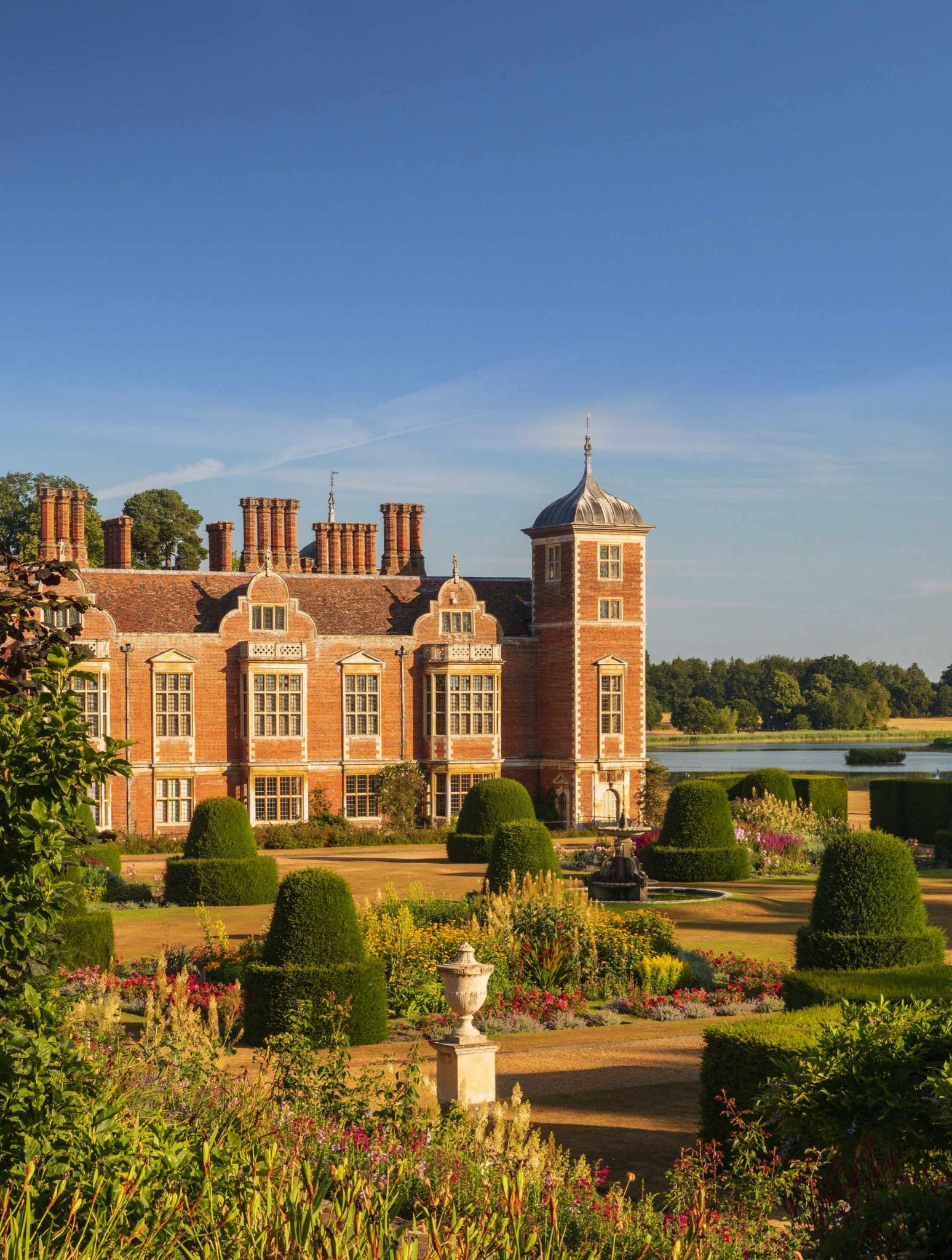
Was Anne Boleyn born in a Tudor house on the Blickling Estate? Well, although there’s no definitive evidence, the sumptuous mansion that replaced it is home to both a statue and a portrait of Henry VIII’s doomed second wife that bear the words ‘Anna Bolena hic nata 1507’ (‘Anne Boleyn born here 1507’). And her parents certainly owned Blickling around that time, so it seems likely that she and
Mary – ‘The Other Boleyn Girl’ – did indeed draw their first breaths here.
One imagines they would both have approved of the grand Jacobean moated house that is the centrepiece of the estate today. One extraordinarily large room – the Long Gallery – was designed so that the family could parade up and down in it when wet weather prevented them from exercising outside. It’s since become a place for exercising one’s brain: a nationally important library holding around 14,000 books.
Life at Blickling was probably at its most ‘Downtonesque’ during the tenure of Philip Kerr, the 11th Marquess of Lothian. A leading light behind the formation of the National Trust, in the 1930s he was also a member of the ‘Cliveden set’. Blickling thus thronged with famous names, such as Nancy Astor and her niece and – scandalously – the German ambassador and leading Nazi, Joachim von Ribbentrop.
Useful info
• House opening hours: 11–4 (tours only in winter).
• Café; restaurant, shop; gardens; parkland; accessible toilets; wheelchair hire.